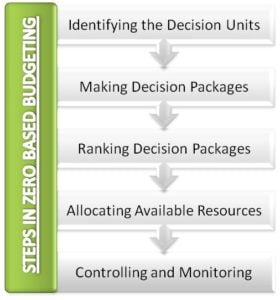Zero-based budgeting (ZBB) is a management tool for controlling the costs in an organization. It is a budgeting method where the organization prepares the current year’s budget from scratch, i.e., taking the base as zero. The old and the new activities of the business are ranked according to their importance. The allocation of available resources to each activity happens on a priority basis without considering the past budgets or achievements. For creating a zero-based budget, a step-wise approach is followed. Let us understand the steps in zero-based budgeting in detail.
Zero Based Budgeting Steps / Process
Identifying the Decision Units
The first and foremost step involved in the zero-based budgeting process is, identifying the decision unit. A decision unit can be a single activity or a cluster of activities that can be independently and meaningfully identified. By independent, we mean an activity that we perform in isolation and not overlapping other activities. So every decision unit will be separate from each other. An organization has many decision units. Each cost center, like the marketing department, production department, human resource department, research, and development department, etc., acts as a decision unit.
This step plays a significant role in justifying each item of expenditure in the budget. The manager of each decision unit has to justify the expenses and required budget allotment for his decision unit. The justification given by the manager should not be based on the prior period budget or based on his decision unit’s expenditure in the preceding year. Since zero-based budgeting is preparing the budget from scratch, therefore the justification for the required budget should also be fresh.

Making Decision Packages
In this step, the decision units identified in the first step are broken down into smaller decision packages. These decision packages must be in line with the objectives of the organization. Each decision package acts as a standalone proposal that is appealing for allocating funds. Each decision package defines the functions, activities, and operations of the proposal, the need for the proposal, economic and intangible benefits associated with the implementation of the proposal, loss of opportunity if funds are not allocated to the proposal, etc. A formal decision package must contain the following information:
- The task for which the decision package is made
- Goals and objectives of broader decision unit of which it is part of
- Goals and objectives of the decision package
- Analyzing the need for the task
- Analysis of the technical and operational viability of the task
- Analyzing the alternative course of action
Ranking Decision Packages
This is the third step in the zero-based budgeting process. In this step, ranking of all the decision packages within a decision unit and among various decision units is in the order of their importance and priority. The logic behind prioritizing decision packages is to allocate scarce resources efficiently. Decision packages are ranked based on the cost-benefit analysis. While doing this, all the alternatives options are evaluated so as to select all the better and more cost-effective options. Top management reserves all the rights to approve or reject a decision package. Only those decision packages are approved, which helps the organization to achieve its predetermined objectives. Management also ensures that the costing in each decision package is accurate and realistic.
Allocating Available Resources
This zero-based budgeting step is an extension of the previous step. The decision packages that were ranked in the previous step are allocated funds in this step. So we can say that in this step, funding decisions take place. The allocation of funds and other resources is based on the ranking of decision packages. So the most promising decision packages get better funding. This ensures optimum utilization of scarce resources.
Controlling and Monitoring
This is the last step in preparing zero-based budgeting. Under this step, decision packages are monitored and evaluated for their performance and output. Measuring the performance of the decision packages helps the management to understand whether the allocation of resources is done accurately or not.
Keep reading Zero Based Budgeting
Conclusion
Since zero-based budgeting is a cost control technique, it is very important that the steps to implement zero-based budgeting are properly and wisely followed. There must be a detailed description of how each department would use the allocated funds and how the organization will benefit from it overall. Though steps involved in the zero-based budgeting process are time-consuming, it provides the most systematic allocation method of a company’s funds.


My partner and I stumbled over here coming from a different web address and thought I should check things out.
I like what I see so now I’m following you. Look forward to checking out your web page for a second time.
appreciate it a great deal this website will be formal and also simple
I could not refrain from commenting. Exceptionally well written!
Well I truly enjoyed reading it. This post procured by you is very effective for correct planning.
I’ll immediately clutch your RSS feed as I can’t find your e-mail subscription link or e-newsletter service.
Do you’ve any? Please let me understand in order that I may subscribe. Thanks
I have read this post and I desire to read more things about it!
Well explained with simple words that assist one to understand, I enjoyed reading from this website.
Thank you.
I understand very well now after a long struggle I have understood even though I’m 18 I even wish to be part of you when l finish my studies
You are most welcomed.